Kingdom Protista
In Lab 6 we began our examination of the fossil record with the cyanobacteria (prokaryotes) that formed stromatolite mounds as long ago as 3.5 BY. These were part of Kingdom Monera. We then moved on to multi-cellular eukaryotes (cells with a nucleus and organelles) of the Precambrian, starting with multi-cellular worms categorized within Kingdom Animalia. We will now return to the single-celled organisms to discuss Kingdom Protista (see Table 6.1), which are single-celled eukaryotes. These organisms can be either photosynthesizers or consumers, and some combine traits of both.
Unicellular members of Kingdom Protista are plentiful in number, often forming the base of the food chains of marine and freshwater ecosystems. Their widespread nature, variety of species, the rapid changes in shell shapes, and their generally good preservation in the fossil record make them excellent guide or index fossils for biostratigraphy. The microscopic size of these organisms allows them to be retrieved intact even from very small rock fragments. In addition, the groups have different ideal growing temperatures and so their identification can often be used to reconstruct water temperatures.
Kingdom Protista has many phyla but we will not be learning the taxonomic details. Instead we will learn the common names of several different groups: the acritarchs, the dinoflagellates, the coccoliths, the diatoms, the foraminifera and the radiolarians. The organisms introduced below include organisms which evolved in the Mesozoic, and those with earlier roots but which became numerous in the Mesozoic.
Phytoplankton with Organic Walls
Phytoplankton are plants that float in water, unattached to a surface. They are primary producers, organisms at the base of the food chain that convert energy from the sun into organic materials (carbohydrates). Consumers (including humans) use these organics as their energy source.
The earliest of the planktonic primary producers in the oceans had an outer covering of organic material. This evolution of an outer covering in unicellular organisms likely began as a way to provide protection from UV light, and also provided protection from consumers able to engulf and eat the single-celled phytoplankton organisms.
Acritarchs (1.8 BY to Recent, Peak in Paleozoic)
Acritarch (Figure 8.1) is a general name given to any organic-walled, container-like fossil that is assumed to have contained a single-celled organism, rather than a proper taxonomic group of organisms. The organisms that occupied the “containers” were likely bacteria, cyanobacteria or members of Kingdom Protista, but the exact nature of the cell inside the “container” is not always known.
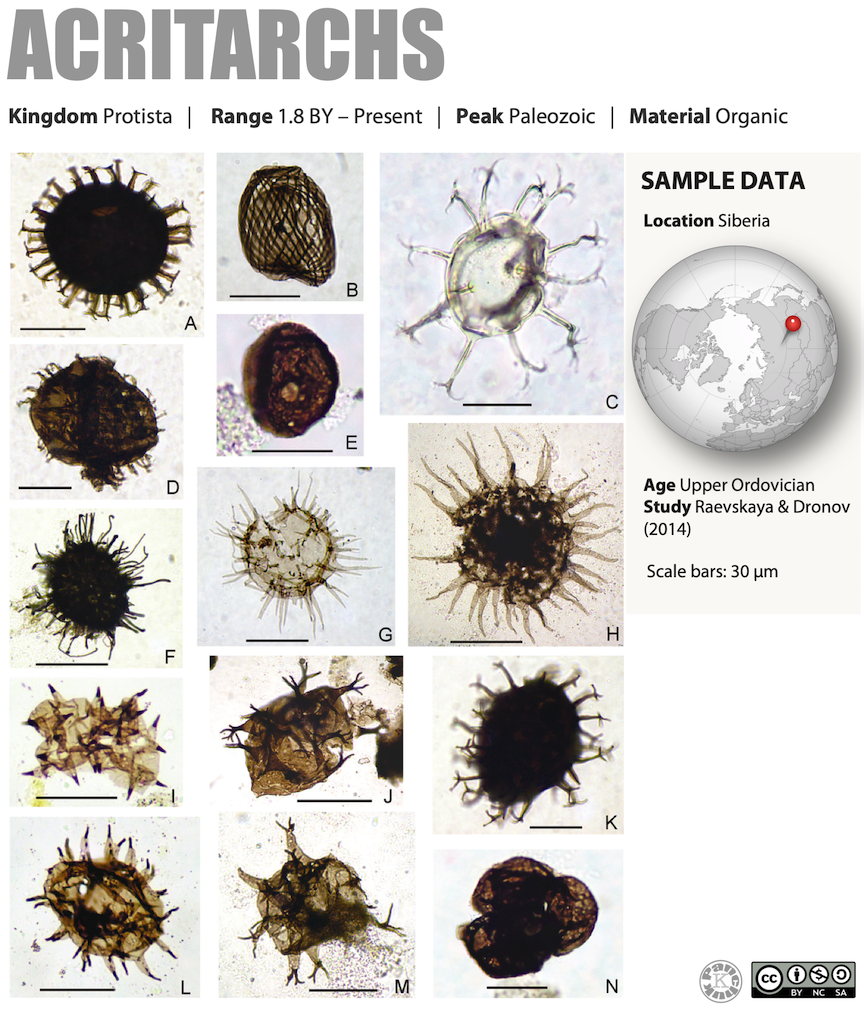
Organic-walled primary producers emerged in the Precambrian and would have been food for Ediacaran animals. The number and variety of acritarchs expanded to make them the primary producers of the Paleozoic oceans. They provided the food source for the new suspension feeders like the brachiopods, bryozoans, cnidarians, bivalves and graptolites. Acritarchs became less important after the Permian extinction when other forms of phytoplankton with mineral walls evolved or diversified.
Dinoflagellates (Triassic to Recent, No Peak)
The acritarchs may have included the ancestors of the dinoflagellates (Figure 8.2) that arose during the Triassic. These photosynthetic unicellular organisms with an organic outer coating are the second most common form of primary producer in the modern ocean, and they also occur in fresh water. The symbiotic algae living with corals discussed in Lab 7 are photosynthetic dinoflagellates. The coral animal provides some nutrients from the water column to the dinoflagellates and in return receives the organic products of photosynthesis from the algae.
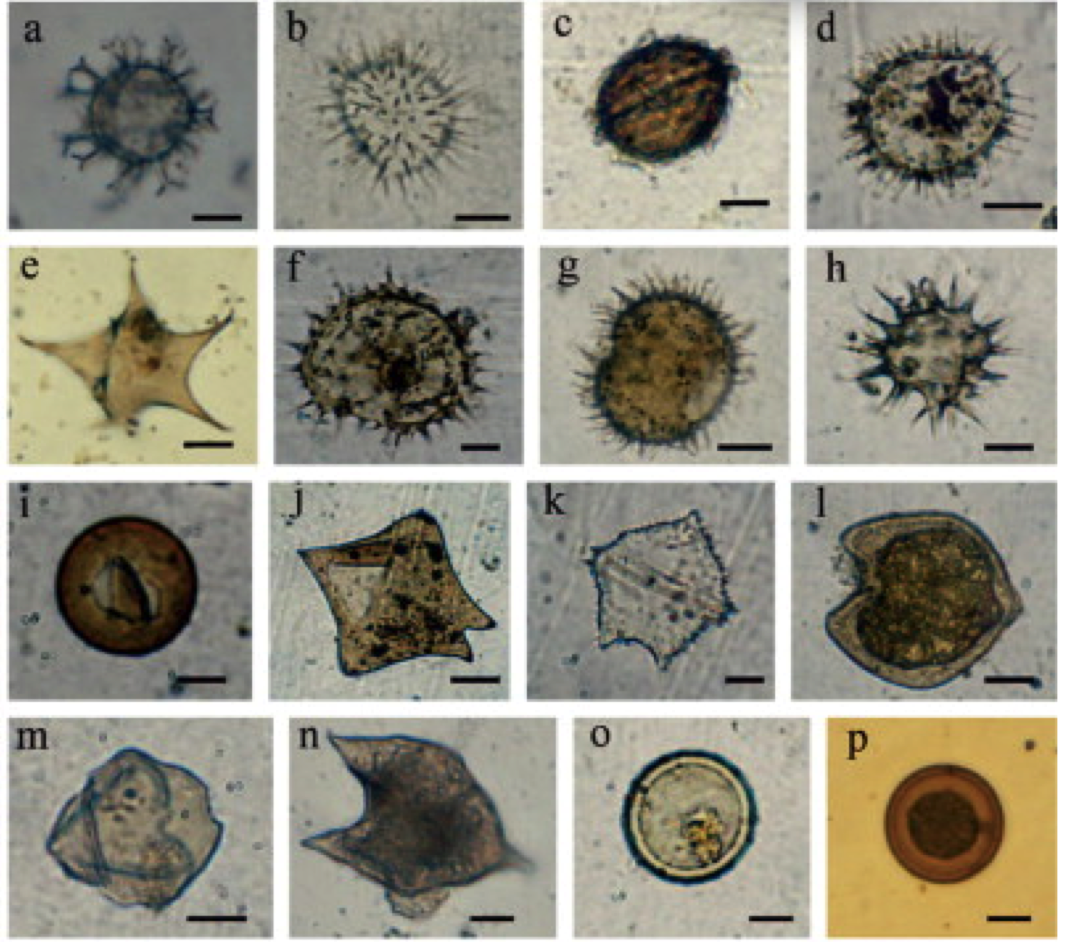
What to Know More About Dinoflagellates and Red Tide?
Summertime blooms of these organisms in B.C. waters are responsible for the phenomena of Harmful Algal Blooms (HAB), sometimes known as “red tide” though not all algal blooms are red in colour. During a bloom, algal organisms such as the dinoflagellates become so numerous that the concentration of their waste products can become toxic. Suspension feeders like oysters and clams can concentrate these waste products in their own tissues, which get passed on to the animals that eat them – including us!
Many algal blooms produce toxins that cause paralysis of the central nervous system. Very small amounts (as little as touching your lips to the seafood stew spoon) may cause numbness of the lips and mouth, and often it does not take much to stop a person’s breathing and lead to death. “Red Tide” warnings are posted on beaches or wharves when blooms are known to have occurred. Most wild shellfish should be approached very cautiously in summer months and only eaten when they are confirmed to be safe. If in any doubt, avoid eating them as the consequences are potentially fatal.
Phytoplankton with Mineral Walls
Coccoliths (Jurassic to Recent, Peak in Cretaceous)
Coccoliths are planktonic photosynthetic algae that evolved in the Mesozoic and were one of the primary producers during the Mesozoic. They are golden brown algae that secrete calcium carbonate skeletal structures about 30 microns in diameter (1 micron = 0.001 mm) that are held to the outside of the cell like little overlapping shields. Most coccoliths have two elliptical discs joined at the centre by a hollow stud, and another type has five radial arms resembling a star (Figure 8.3). These plates fall off the organism when it dies and sink to the sea bottom, forming rock deposits known as chalk. The White Cliffs of Dover are large Mesozoic chalk deposits in southern England on the English Channel.

Try It!
The image below is classroom chalk. Zoom in to enlarge the region with the blue circle. An intact coccolithosphere (all the plates still attached) is present. Examine the plates closely, then look around the image to find examples of those plates (often broken) scattered throughout.
Note: If the image does not load, click here to open it in a new window.
Diatoms (Cretaceous to Recent, Peak in Recent Times)
Diatoms (Figure 8.4) are planktonic photosynthetic algae that were present in the Mesozoic, but they became more important during the Cenozoic and now are the most important primary producers of the modern oceans. They have beautifully constructed cell walls of silica that are 2 – 200μm (0.002 mm to 0.2 mm) in size, that are made up of two parts that fit together like a box.

After these organisms die, they sink and accumulate on the basin floor forming a rock commonly called diatomaceous earth (Figure 8.5). This is a lightweight porous rock that is used as a filter aid, paint extender, “natural” insecticide, and is sometimes even added to food.
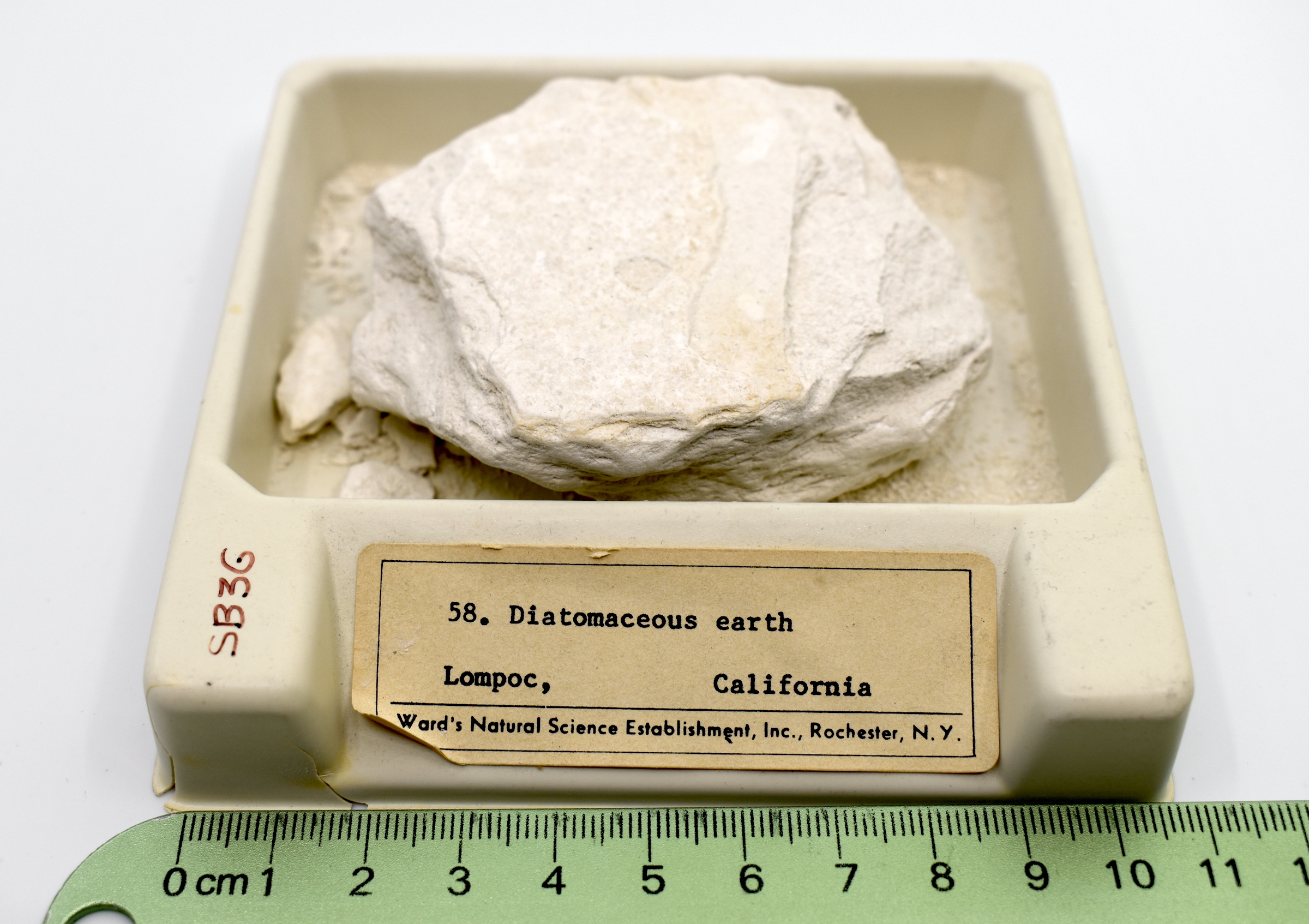
Try It!
If you ground up the rock in Figure 8.5, and magnified the powder, you would see something similar to the image below. Zoom in and see if you can spot the cylindrical diatoms.
Note: If the image does not load, click here to open it in a new window.
Unicellular Primary Consumers
Foraminifera (Cambrian to Present, Peaking Jurassic to Present)
Foraminifera (or “forams”; Figure 8.6) are single-celled primary consumers that consume the primary producers discussed above. Forams build shells (called tests) of secreted calcite, or rarely of silica or aragonite. The tests have one or many chambers, usually arranged in spirals or coils. Most are benthic dwellers, but some are pelagic (click here to review habits in Lab 7). Forams with carbonate tests contribute to the formation of chalk.
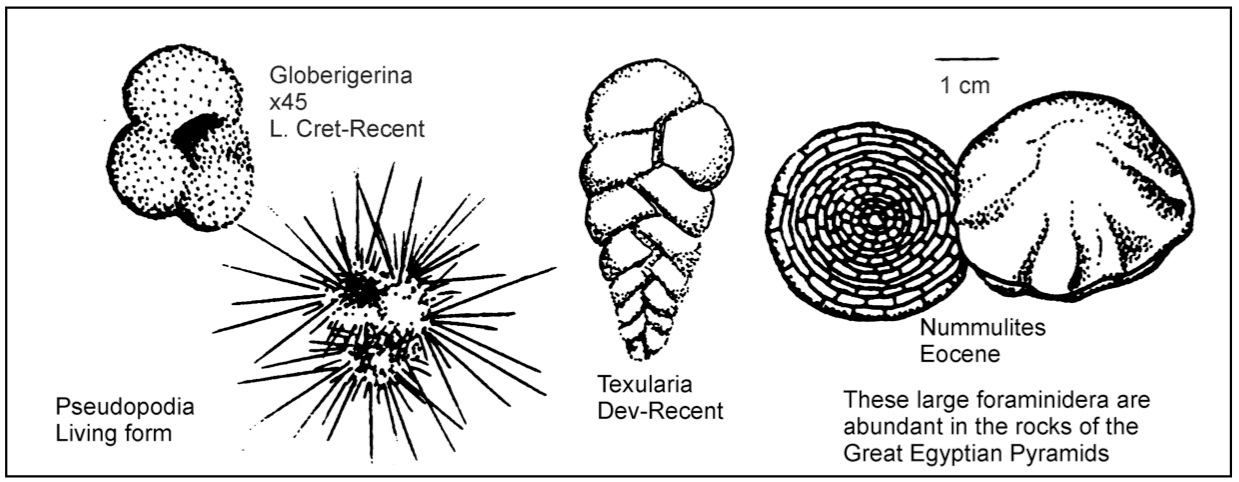
Radiolaria (Cambrian to Present, No Peak)
The radiolarians (Figure 8.7) are smaller than foraminifera and make their shells of silica. They are commonly bell-shaped or spherical with an open, sieve-like texture. Radiolarians are marine pelagic animals (zooplankton). Their skeletons form a siliceous ooze on the sea floor that is stable at depths of over 4,500 metres. In contrast, calcareous shells dissolve below that depth.
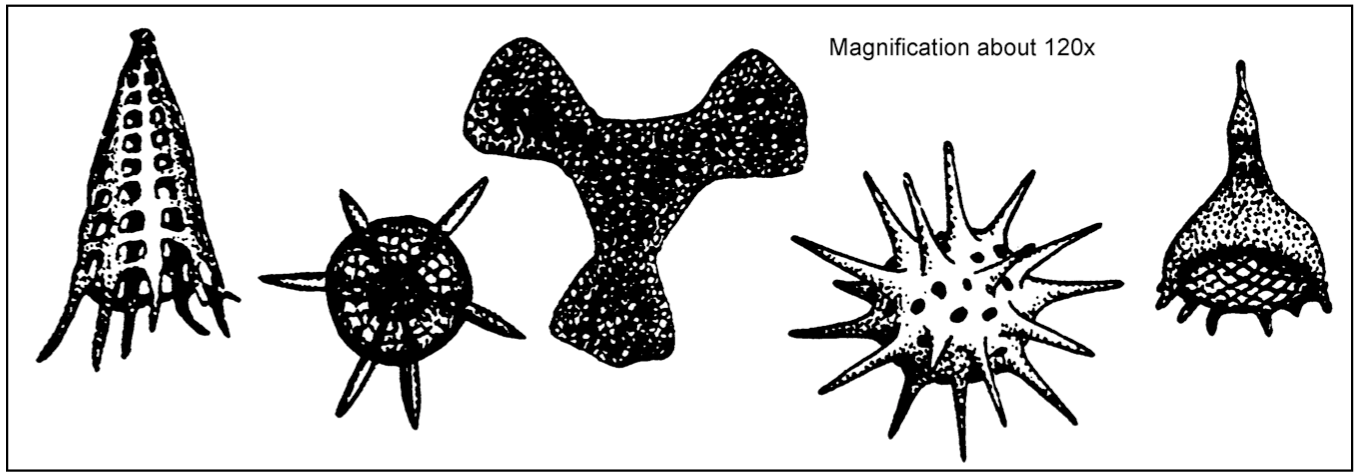
Questions a-i
a. List the members of Kingdom Protista who are:
i. Primary producers
ii. Primary consumers
b. Which term describes the metabolism of primary producers: heterotrophoic, chemotrophic, or autotrophic? Write a short definition of the term you selected.
c. What is the name of the biochemical mechanism that primary producers use to capture and convert sunlight energy?
d. Which term describes the metabolism of primary consumers: heterotrophoic, chemotrophic, or autotrophic? Write a short definition of the term you selected.
e. What were the likely reasons for the evolution of an organic outer covering for early phytoplankton in the Precambrian?
f. What is the life habit of a dinoflagellate?
g. What environment range(s) do dinoflagellates inhabit: photic, bathyal, or abyssal?
h. What is the life habit of a foraminifera?
i. What is the primary difference between coccoliths and diatoms?
References
Narale, D. D., Patil, J. S., & Anil, A. C. (2013). Dinoflagellate cyst distribution in recent sediments along the south-east coast of India. Oceanologia, 55(4). 10.5697/oc.55-4.979.
Raevskaya, Elena & Dronov, A. (2014). New data on acritarchs from the Upper Ordovician of the Tungus basin, Siberian Platform. Estonian Journal of Earth Sciences. 63. 300. 10.3176/earth.2014.34.

